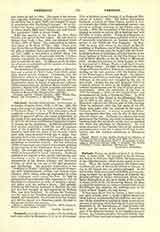

Farinato, PAOLO, an Italian painter, b. at Verona, 1524; d. there, 1606. He belonged to the old Florentine family of Farinata degli Uberti, the famous head of the Ghibelline party, whom Dante placed in his Inferno. When the Guelfs triumphed, the Uberti were expelled and part of the family settled at Verona; it was to this branch that the painter belonged. In his native town Paolo was a pupil of Giolfino, who was carrying on there the artistic tradition of Liberale, the greatest perhaps of Italian miniaturists whose wonderful illustrations in the choir books of the Libreria of Siena (1470-1476), his blustering Boreas, his Mass in which the celebrant is a turbaned priest with a head like Klingsor the magician, his startling view of the Castle of Sant Angelo, are well known.
It thus came about that in Verona, a town without any great artistic past, a really original school was being formed, untrammelled by traditions and therefore all the more free to indulge in those novel color. schemes in painting which had already found startling expression in the mausoleums of Cane Grande della Scala, and the barons of his family. Towards the close of the fifteenth century, in the neighborhood of Verona, the Venetian masters, Giovanni Bellini, Giorgione, and Titian, had just brought about a great artistic revolution. They had invented coloring as an essential branch of the painter’s art. But great masters that they were, they were also men of intellectual genius and cared too much for the idea and its expression to give themselves up utterly to the purely sensual ideal they had discovered.
The Veronese School, on the contrary, less concerned with the higher walks of art, and untrained in the quest of lofty ideals, seized straightway on coloring as the language best suited to express its own temperament. Coloring soon became its unique preoccupation; and it was from this school the greatest colorist and painter of all time was to come forth, if the measure of greatness among painters is their ability to speak in coloring, Paolo Caliari, of Verona, known as Veronese. It is on this account that Giolfino and his pupils, Brusasorci and Farinato, are of such interest in the history of art. It is in their works that we note the blending of the two styles, and the use of coloring as an exclusive source of pleasure in painting: they were the heralds of Veronese and his immediate precursors. More than one sketch by Brusasorci is even now masquerading as a Veronese. Moreover, in the hands of these artists painting gradually loses its moral purpose and becomes merely one of the decorative arts, giving promise already of that gaudy evolution that was to end in Tiepolo.
In this transformation Farinato played a very important part. He had a decided talent for fresco, and like Liberale, he was largely occupied on the decorations of the facades of the houses in Verona, which give that town and its famous Piazza dell Erbe so winsome and engaging an appearance. Unfortunately, Farinato did not remain faithful to his native genius. At Mantua he fell under the influence of Giulio Romano, who, with his own captivating though vulgar faults, had inherited all the prestige of the divine Raphael. It was under this influence that Paolo executed his “St. Martin” in the Blessed Sacrament Chapel of the cathedral at Mantua: and from this time onward his works betray for the most part a hybrid compromise between the corrupt Roman style and the light impressionist coloring of Veronese. In Mantua also his principal works are preserved. In Santa Maria in Organo, a “Massacre of the Innocents” (1556), and a “Christ Walking on the Waters” (1558); in San Tommaso, a “Glorification of the B. Virgin” (1569); in Sant Anastasia, a “Pentecost” (1598), and in San Giorgio in Braida, a “Multiplication of the Loaves” (1603).
Though four years older than Veronese, Farinato survived him by nearly twenty years, and was over eighty when he died. He was a most prolific painter and many of his works have found their way to other lands. In the United States there are two or three, one at Cleveland, in the Holden Collection, an allegory of “Autumn”; one at New Haven in the Jarves Collection, “Christ Appearing to Some Saints”; and one at the Historical Society in New York, an “Abraham Driving away Hagar”. The famous painting in the Louvre, representing “The Council of Trent“, and generally attributed to Titian, has been assigned to Farinato by Berenson.
LOUIS GILLET

